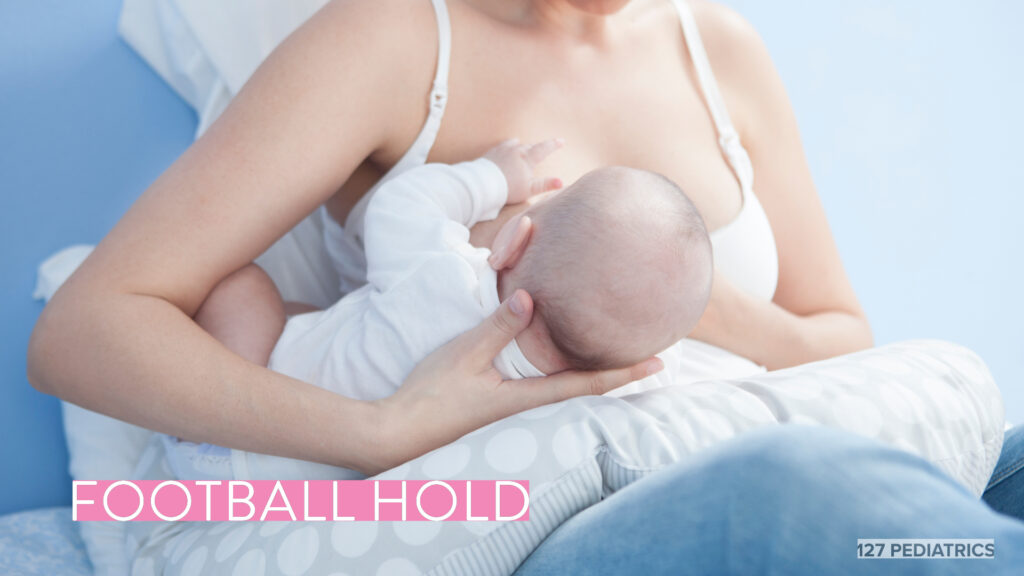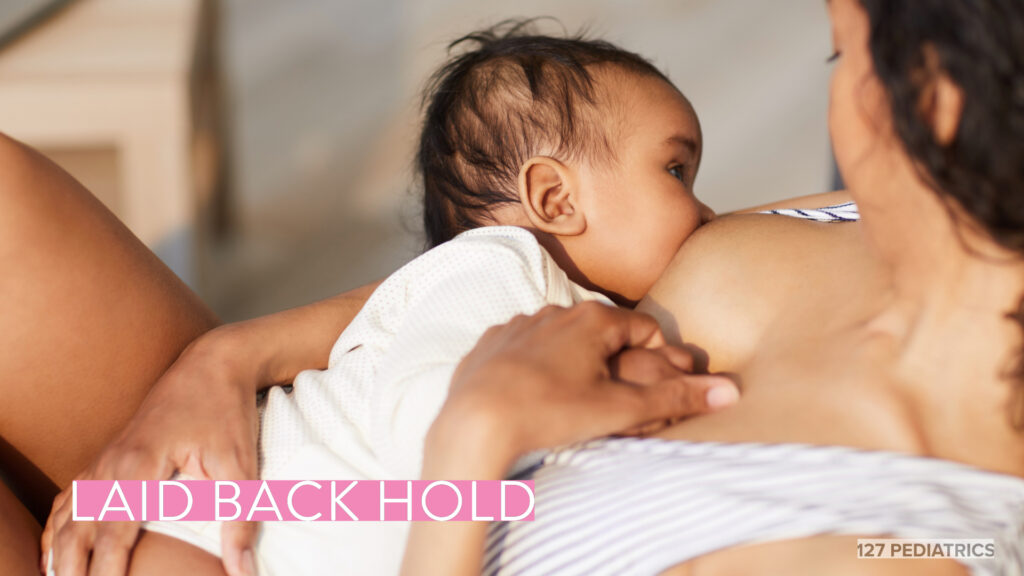Breastfeeding positions hold the keys to a successful breastfeeding journey.
Candace has just had her first baby and she was trying to figure out this whole breastfeeding thing. She was transferred to the postpartum floor from labor and delivery. Her baby became one of my patients, so I headed to her room to see them. I was a newborn hospital pediatrician at the time and I cared for all of the babies during their newborn hospital stay.
When I got to Candace’s room, both she and the baby were crying. This is definitely something that I encountered regularly on this busy postpartum floor. I sat down in the chair next to her bedside, handed her a tissue and asked her if I could see the baby.
While I was examining this tiny new human, I chatted with Candace about how she was feeling. As she dried her tears, she expressed to me that she was really frustrated with breastfeeding. She had kind of done some research about it before her little one was born, but never took a formal breastfeeding class. As a first time mom, she had been more focused on what her birth would be like and centered her learning around that topic. However, she expressed to me that she didn’t even know how to hold her baby for breastfeeding.
Breastfeeding Tips for Successful Breastfeeding
This was not the first time that this scenario played out while I was rounding on new babies on the postpartum floor. Regularly, new mothers would look up at me while they were holding the newest member of their family and ask me how to breastfeed. While I was able to give them a crash course and some hands on attention in the moment, it was not something that was easy for them to remember through their exhaustion.
In my own breastfeeding experience, I was a lot like Candace. I failed to do much preparation for breastfeeding before my daughter was born. For this reason, I worked to become an expert in breastfeeding so that I could help other women avoid the mistakes that I made as a new mother. So much of breastfeeding is time sensitive, that it is imperative to learn about breast feeding prior to giving birth. One of the most important things to learn is how to hold your baby using the common breastfeeding positions. Learning the position for breastfeeding does not guarantee your success, but it does set you up with a solid foundation.
In this article, we will examine how to accomplish the common breastfeeding positions, as well as the advantages and disadvantages of each position. My hope is to set you up for success in your breastfeeding journey.
Common breastfeeding positions
While breastfeeding is not one-size-fits-all, there are some fundamentals that hold true for every mother. These different breastfeeding positions have specific names so that it is easier to communicate about them. Certainly, you do not need to memorize the different names, but it is extremely helpful to understand the different ways to position baby for breastfeeding.
Additionally, it is important for you to know that these positions are meant to help you in the early days of breastfeeding. Once you get the hang of how to get your baby to latch to the breast, you don’t need to follow these exact steps every time. There are benefits of each position, and I will tell you which one that I like the best for new moms who are just starting out.
These steps are true for every position:
- Sit in bed or a comfortable chair (A chair with arm rests can be helpful)
- Place pillows in your lap and all around you for support (regular pillows or a nursing pillow)
- Hold baby tummy to tummy (baby against your tummy) and nipple to nose
- Position your own body in a way that you can bring the baby to you and not the other way around

Cradle Hold
Many moms find the cradle hold to be the most familiar and natural way of holding a baby. It provides comfort and security to the baby while nursing.
Steps for the cradle hold:
- Place your baby’s head in the crook of your arm
- Use that arm to support your baby’s head and rest their body on your forearm.
- Place your opposite hand on your breast and grasp it gently using a C-shaped hand formation
- Position your nipple near the baby’s mouth and wait for them to open wide.
- Gently and quickly guide the baby towards the breast to latch on.
Benefits of this position:
- Familiar and natural for most mothers
- Easy to support the baby and bring them close
Drawbacks:
- When you are first learning how to breastfeed, it is easy to position the baby’s head too high for a successful latch on

Cross – Cradle Breastfeeding Position
The cross-cradle position is a variation on the cradle hold.
Steps for the cross-cradle hold:
- Position your hand behind your baby’s neck and shoulders (the hand opposite the breast that you are going to nurse from)
- Baby’s body should be in line with the rest of your arm
- Use your other hand to position your breast (same hand as the breast you are using)
- With a C-shaped formation, use your hand to sandwich your breast tissue in the direction of the baby’s mouth
- Encourage the baby to open their mouth by gently rubbing the side of their mouth with your finger or nipple
Once baby opens wide, gently and quickly pull the baby towards you for a latch on
Benefits of this position:
- Allows you more control over the baby’s head and neck (especially when they have little head control in the days after birth)
- More likely to latch the baby on in the correct position (allowing baby to get a mouthful of breast)
- Great position for newborns, especially premature babies
Drawbacks:
- Easy to “shove” the baby’s head into the breast

Football or Clutch Hold
The football or clutch hold is the next breastfeeding position we will cover.
Steps for football hold:
- Start by placing the baby under your arm on the side of the breast you are using
- Baby’s body should be parallel to your side
- Support their feet against a pillow or couch
- Cradle their head, neck, and shoulders in your hand.
- Use your opposite hand to position your hand in a C-formation around your breast
- Wait for the baby to open their mouth wide and gently pull the baby towards the breast
Benefits of this position:
- Excellent visibility, allowing for easier assessment of the baby’s latch and positioning
- Great for women with large breast size (improves alignment, support of the breast and milk flow)
- Helpful for women with nipples that don’t point straight ahead
- Takes pressure off of mom’s belly after a cesarean birth
- Makes feeding twins at the same time easier
Drawbacks:
- Some women find this position challenging to learn

Side-Lying Breastfeeding Position
The side-lying position is a comfortable breastfeeding position for both mom and baby.
Steps for side-lying position:
- Mother and baby should lie on their sides facing each other
- Your lower arm should be extended forward and upper arm comfortably placed above your head
- The baby’s head should be at breast-height for easy access
- To maintain a proper latch, the mother can gently support the baby’s head with her hand or a nursing pillow
Benefits of side-lying position:
- Makes feeding the baby overnight easier
- Gives you a break after a long or busy day at work
- Helpful for mothers right after a cesarean birth to keep pressure off their belly
Drawbacks:
- Easy to fall asleep while nursing the baby

Laid-Back Position
The laid-back breastfeeding position is helpful for many different situations.
Steps for laid-back nursing position:
- Hold baby in a semi-upright to upright position in your lap
- Align the baby’s mouth with your nipple
- Once the baby opens their mouth wide, gently and quickly pull the baby in for latch on
- Lean back in a semi-reclined position that is comfortable for both you and the baby (you can use pillows to support both of you in this position)
Benefits of the laid-back position:
- Allows babies more freedom for self attachment
- Helps employ gravity to slow a fast letdown
Drawbacks:
- Takes some practice to master
There are additional upright breastfeeding positions that we won’t go into in this article. They are most helpful for very specific situations.
Do you need to switch positions?
There are multiple reasons to consider changing positions during a feeding session. Switching things up can be beneficial for the baby’s comfort, milk flow, and to prevent or address any breast soreness. Some indicators that it might be time to switch positions include:
- Fussy or agitated baby
- Your baby is having a difficult time with achieving a latch
- Pain or discomfort for you (sore nipples)
It is also important to follow the baby’s feeding cues as well as fullness cues. The baby may need a new position or they may just be done with the feeding. Generally, it’s okay to switch positions whenever necessary. Often, you will find a position that both you and the baby like. If you have a preferred nursing position for every feeding and it works for you, there’s no need to change it.
Can you breast feed in bed?
Breastfeeding in bed next to your baby is a great benefit of breastfeeding. This is more difficult if you are bottle feeding, but for sure breastfeeding mothers can take advantage of nursing in bed. Often, the side lying position also allows for more skin to skin contact with your baby.
However, please keep safety in mind when nursing your baby in bed. Make sure the environment is safe for nursing in bed. Remove loose or bulky bedding to prevent suffocation. Keep pillows away from the baby’s head and check for any spaces where they could get stuck. If you are excessively tired or have consumed substances that affect your alertness, avoid breastfeeding while lying down.
After nursing, put the baby back in their own separate sleeping surface, ideally in the same room as you. The AAP and most pediatricians recommend not sleeping in the same bed with your new baby. While breastfeeding protects babies from such things as ear infections, GI infections and sudden infant death syndrome, it does not protect them from being trapped under an adult or up pinned against the side of the bed.
How can 127 Pediatrics help with additional breastfeeding tips?
At 127 Pediatrics, we believe that all women who want to breastfeed should be able to do so successfully. We are here to help you wherever you are on your breastfeeding journey. Here are some additional articles that you may find helpful:
Unlock the Secrets of an Optimal Breastfeeding Latch
When Should I Start Pumping as a Breastfeeding Mother?
Seven Ways to Prepare for Breastfeeding
In addition, you can subscribe to our YouTube channel and join our email list to get weekly breastfeeding content delivered to you.
This article is not intended to be interpreted as medical advice. It is for educational purposes only.
© 127 Pediatrics, March 2022, updated April 2024

Dr. Andrea Wadley is the owner of 127 Pediatrics. She is board certified in both pediatrics and breastfeeding medicine. As a mother, pediatrician and breastfeeding expert, she brings a wealth of expertise and experience to all of her patient encounters.


